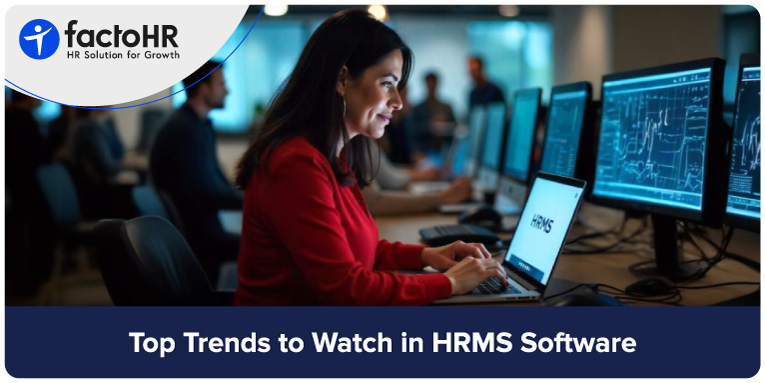Top 10 HR Software Trends to Streamline Workflows

Table of Contents
Gone are the days when the HRMS software was only an administrative tool. In fact, it is increasingly becoming important from a strategic point of view. Earlier, HRMS was only used for tasks such as payroll calculation, attendance monitoring, and leave management. Now, it is also implemented for managing performance, predicting turnovers, and anticipating future workforce demands.
An online HR software is crucial for managing today’s hybrid and remote workforces. This is because it offers features such as flexible shift management, online attendance, and self-service portals. HRMS software also enhances employee engagement and facilitates compliance with various regional regulations.
As an HR manager, you should be keeping track of top HRMS tech trends to increase your organization’s overall efficiency. This blog reiterates the importance of HRMS and highlights 10 HR tech trends 2025.

Keeping an Eye on HRMS Software Trends in 2026
Some of the more notable HR tech trends are the adoption of Artificial Intelligence (AI), hyper-automation, and personalized employee experiences. Let’s examine these and other trends in more detail.
Artificial Intelligence (AI) and Machine Learning in HRMS
Artificial intelligence (AI) and machine learning are significantly transforming HR operations, including recruitment, performance management, and employee engagement.
- AI in recruitment can predict a candidate’s success by comparing the candidate’s profile with the profiles of successful employees.
- AI in HRMS can also help in conducting performance assessments by analyzing employee performance according to specified criteria.
- According to Deloitte, “AI-enabled skills-based organizations are 63% more likely to achieve organizational outcomes.” This finding emphasises AI’s role in identifying and plugging skill gaps.
- AI-powered chatbots can help employees resolve queries related to payroll and tax calculations, leveraging machine learning capabilities.
Hyper-Automation of HR Processes
HR process automation is another key tech trend of 2025. Almost every HR function, including payroll calculations, performance appraisals, attendance tracking, and leave management, will be automated.
- The HR software would automatically calculate the tax deductions and arrears calculations based on the set criteria.
- The performance management software would automate the scheduling of periodic reviews. Additionally, a cloud-based solution would eliminate the need for in-person meetings to provide feedback.
- The HRMS will allow for online attendance marking. Also, it will provide dashboards to HR professionals for monitoring employee time off and absenteeism.
- Employees will be able to manage their leaves on employee self-service portals and the mobile app. Managers will face less hassle when approving leaves because they will be able to approve leave requests in bulk.
Enhanced Employee Experience Platforms
The increasing demand for personalized experiences has made employee platforms more significant. Organizations are investing in platforms that offer 24/7 support, online leave applications, and ease of viewing employee information. Modern self-service portals that provide sentiment analysis, continuous feedback, and a digital employee experience are also in high demand.
Hybrid and Remote Workforce Management
As the new standard, hybrid and remote workforce management will be another HR trend in 2025. In such a scenario, organizations should invest in remote HR solutions as:
- They offer features such as team leave calendars to address any potential issues related to staff availability,
- Provide face-recognition and geofencing capabilities for managing attendance,
- Integrate ESS portals for engaging employees and for communicating organizational changes, and
- Store data on a cloud-based solution for ease of access.
Cybersecurity and Data Privacy
There are two primary factors responsible for this trend.
- Increasing cyber attacks due to the rise in remote work, and
- Adoption of data-privacy regulations such as GDPR and Digital Personal Data Protection Act, etc.
Consider a cloud-based solution to protect sensitive employee information and ensure compliance with audit requirements. Secure, end-to-end encryption storage will provide comprehensive protection for employee data. Additionally, central data storage offers real-time access to your data.

Advanced Analytics and Data-Driven Decision Making
Leaders are utilizing various advanced forms of analytics to make data-driven HR decisions, and HR analytics will continue to be critical in 2025 as well.
- Predictive analytics in HR would aid in workforce management by predicting turnover rates and forecasting future talent needs.
- Diagnostic analytics will play a crucial role in identifying potential areas for improvement, as they pinpoint the root causes behind a problem.
- You can also combine predictive and prescriptive analytics. Predictive analytics would estimate potential turnover rates, while prescriptive analytics would provide actionable solutions for retaining employees.
Integration with Other Business Systems
Integration of HR software with internal and external modules is a necessity because:
- Integrating built-in modules simplifies HR operations. It also ensures data accuracy.
- Integrating with external systems, such as accounting systems and ERP systems, streamlines payroll management and attendance tracking.
- Integrated systems provide the macro overview of an organization. For example, integrating leave, payroll, and performance modules can help in identifying high and low performers.
Focus on Employee Well-Being and Mental Health
After the COVID-19 pandemic, employee health and well-being have gained noticeable traction. Some ways to support employee well-being programs are:
- Mood analysis. HR managers should rely on features like employee mood tracking for addressing any potential issues.
- Employees should be able to raise complaints at any time, 24 hours a day.
- AI-powered chatbots may also be helpful if the employee prefers confidentiality.
- There should be a hassle-free leave application process for availing leaves.
Sustainability and Social Responsibility Features
Diversity, equity, and inclusivity (DEI) is another notable trend. So, the following features will be critical to have in 2025:
- AI-powered recruitment process, where AI filters the job descriptions and removes phrases that are prejudicial towards race or ethnicity.
- Diversity dashboards, where managers can view the analytics related to different segments of workforce demographics.
Organizations are also favoring cloud-based software to address climate-related issues, as digital software minimizes paperwork and reduces environmental impact.
Future-Ready HRMS: Cloud and Mobile-First Approaches
HRMS platform provides digital-first processes is one of the top priorities of businesses. Many HR functions, such as onboarding, performance evaluation, payroll processing, and leave management, can be streamlined by using a cloud-based HR software. Additionally, as smartphones become the digital workplace, modern HR tools offering mobile-friendly modules will become increasingly important.

Conclusion
This blog focuses on the 10 most important HR tech trends 2025. AI, automation, and personalized experience are the future of the HR market. AI-driven analytics will revolutionize talent management and recruitment by predicting the success of employees and candidates. Hyper-automation of HR processes will save your HR professionals’ time, enabling them to focus on other strategically important operations.
Businesses across regions are investing in modern HR tools to survive in this competitive environment. You should also evaluate the available options and invest in a state-of-the-art HR software to stay ahead of the curve!
Grow your business with factoHR today
Focus on the significant decision-making tasks, transfer all your common repetitive HR tasks to factoHR and see the things falling into their place.

© 2025 Copyright factoHR


